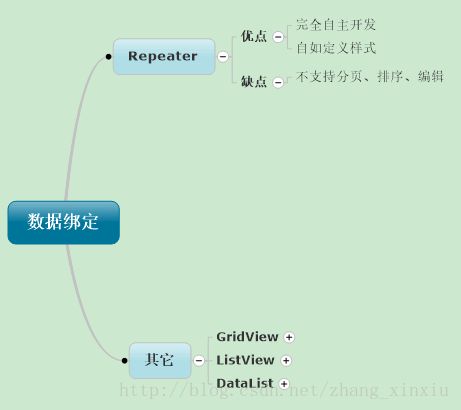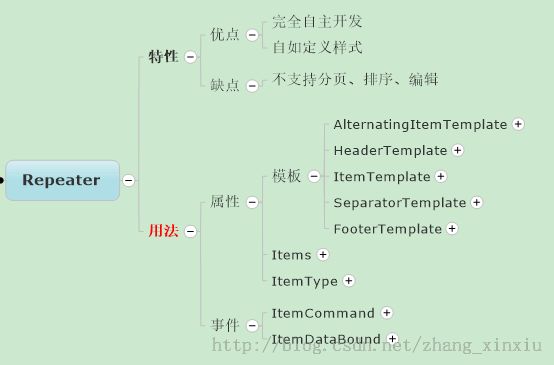详解ASP.NET数据绑定操作中Repeater控件的用法

一、绑定控件之Repeater
封装了多种数据绑定控件,诸如GridView、DataList等但该篇文章将会从Repeater入手,因为Repeater只提供了基本的数据绑定模板,没有内置其它分页等功能,所以它是最原始的数据绑定控件,只要能够熟练运用Repeater控件其它的绑定控件也就很简单了。
1、Repeater简介
Repeater 控件是基本模板化数据列表。 它不像GridView控件一样能够可视化的设计格式或样式,因此开发时在控件模板中必须显式声明所有格式、格式和样式标记。另外Repeater控件没有内置选择、排序、编辑、分页等功能,它只提供了基本的数据绑定,但是它为开发人员提供了ItemCommand 事件,该事件支持在控件中收发命令。
想要绑定数据,模板是必不可少的,Repeater控件同样支持数据模板,而且还可以在模板中添加想要的标签,它主要用法如下图:

Note:每个 Repeater 控件必须定义 ItemTemplate。

二、控件使用技巧
上文讲解了Repeater基本的使用方法及它的一些基本特性,接下来做几个经典的示例来运用Repeater控件。
1、数据绑定之删除、编辑
该示例将会使用Asp的前台和后台结合来实现显示数据,并能够编辑和删除数据。
删除页面:

编辑页面:

前台代码:在单击编辑按钮后将会进入编辑页面,页面是由两个Panel控件来控制,通过传递ID号的方式判断显示的是编辑页面还是删除页面,另外前台代码通过设置控件的CommandArgument属性来传递后台所需要判断的id号。
<body> <form runat="server"> <div> <asp:Repeater runat="server" OnItemCommand="userRepeat_ItemCommand" OnItemDataBound="userRepeat_ItemDataBound"> <HeaderTemplate> <table border="1" style="width:1000px;text-align:center;border-collapse:collapse;"> <thead style="background-color:red;"> <tr> <th>ID</th> <th>内容</th> <th>操作</th> </tr> </thead> </HeaderTemplate> <ItemTemplate> <asp:Panel runat="server"> <tr> <td><asp:Label runat="server" Text='<%#Eval("id") %>'></asp:Label></td> <td><%#Eval("name") %></td> <td> <asp:LinkButton CommandName="Edit" CommandArgument='<%#Eval("id") %>' runat="server">编辑</asp:LinkButton> <asp:LinkButton CommandName="Delete" CommandArgument='<%#Eval("id") %>' runat="server">删除</asp:LinkButton> </td> </tr> </asp:Panel> <asp:Panel runat="server"> <tr> <td><asp:Label runat="server" Text='<%#Eval("id") %>'></asp:Label></td> <td><asp:TextBox runat="server" Text='<%#Eval("name") %>'></asp:TextBox></td> <td> <asp:LinkButton CommandName="Cancel" CommandArgument='<%#Eval("id") %>' runat="server">取消</asp:LinkButton> <asp:LinkButton CommandName="Update" CommandArgument='<%#Eval("id") %>' runat="server">更新</asp:LinkButton> </td> </tr> </asp:Panel> </ItemTemplate> <FooterTemplate> </table> </FooterTemplate> </asp:Repeater> </div> </form> </body>后台代码:在后台代码中很重要的两个事件是ItemCommand和ItemDataBound,其中ItemCommand负责接收前台传进来的按钮命令,根据命令的参数来设置后台传递的id,并在ItemDataBound中来验证id判断切换显示Panel。
using System; using System.Collections.Generic; using System.Data; using System.Data.SqlClient; using System.Web; using System.Web.UI; using System.Web.UI.WebControls; namespace WebApplication4 { public partial class EditPage : System.Web.UI.Page { private int id = 0; //保存指定行操作所在的ID号 /// <summary> /// 窗体加载时绑定数据 /// </summary> /// <param name="sender"></param> /// <param name="e"></param> protected void Page_Load(object sender, EventArgs e) { if (!Page.IsPostBack) { this.DataBindToRepeater();//将数据绑定到Repeater控件上 } } /// <summary> /// 将数据源绑定Repeater控件上 /// </summary> private void DataBindToRepeater() { //使用using语句进行数据库连接 using (SqlConnection sqlCon=new SqlConnection("server=.;database=MyBlog;uid=sa;pwd=1")) { sqlCon.Open(); //打开数据库连接 SqlCommand sqlcom = new SqlCommand(); //创建数据库命令对象 sqlcom-commandText = "select * from match"; //为命令对象指定执行语句 sqlcom.Connection = sqlCon; //为命令对象指定连接对象 this.userRepeat.DataSource = sqlcom.ExecuteReader(); //为Repeater对象指定数据源 this.userRepeat.DataBind(); //绑定数据源 } } /// <summary> /// Repeater控件命令事件 /// </summary> /// <param name="source"></param> /// <param name="e"></param> protected void userRepeat_ItemCommand(object source, RepeaterCommandEventArgs e) { //获取命令文本,判断发出的命令为何种类型,根据命令类型调用事件 if (e-commandName=="Edit") //编辑命令 { id = int.Parse(e-commandArgument.ToString()); //获取命令ID号 } else if (e-commandName=="Cancel") //取消更新命令 { id = -1; } else if(e-commandName=="Delete") //删除行内容命令 { id = int.Parse(e-commandArgument.ToString()); //获取删除行的ID号 //删除选定的行,并重新指定绑定操作 this.DeleteRepeater(id); } else if (e-commandName == "Update") //更新行内容命令 { //获取更新行的内容和ID号 string strText = ((TextBox)e.Item.FindControl("txtName")).Text.Trim(); int intId=int.Parse(((Label)e.Item.FindControl("lblID")).Text); //更新Repeater控件的内容 this.UpdateRepeater(strText,intId); } //重新绑定控件上的内容 this.DataBindToRepeater(); } /// <summary> /// 删除行内容 /// </summary> /// <param name="intId">删除行所在内容的ID</param> private void DeleteRepeater(int intId) { using (SqlConnection sqlCon = new SqlConnection("server=.;database=MyBlog;uid=sa;pwd=1")) { sqlCon.Open(); //打开数据库连接 SqlCommand sqlcom = new SqlCommand(); //创建数据库命令对象 sqlcom-commandText = "delete from match where id=@id"; //为命令对象指定执行语句 sqlcom.Connection = sqlCon; //为命令对象指定连接对象 //创建参数集合,并向sqlcom中添加参数集合 SqlParameter sqlParam = new SqlParameter("@id", intId); sqlcom.Parameters.Add(sqlParam); sqlcom.ExecuteNonQuery(); //指定更新语句 } } /// <summary> /// 更新Repeater控件中的内容 /// </summary> /// <param name="strText">修改后的内容</param> /// <param name="intId">内容所在行的ID号</param> private void UpdateRepeater(string strText,int intId) { using (SqlConnection sqlCon = new SqlConnection("server=.;database=MyBlog;uid=sa;pwd=1")) { sqlCon.Open(); //打开数据库连接 SqlCommand sqlcom = new SqlCommand(); //创建数据库命令对象 sqlcom-commandText = "update match set name=@str where id=@id"; //为命令对象指定执行语句 sqlcom.Connection = sqlCon; //为命令对象指定连接对象 //创建参数集合,并向sqlcom中添加参数集合 SqlParameter[] sqlParam = { new SqlParameter("@str", strText), new SqlParameter("@id", intId) }; sqlcom.Parameters.AddRange(sqlParam); sqlcom.ExecuteNonQuery(); //指定更新语句 } } /// <summary> /// Repeater控件数据绑定时发生的事件 /// </summary> /// <param name="sender"></param> /// <param name="e"></param> protected void userRepeat_ItemDataBound(object sender, RepeaterItemEventArgs e) { //判断Repeater控件中的数据是否是绑定的数据源,如果是的话将会验证是否进行了编辑操作 //ListItemType 枚举表示在一个列表控件可以包括,例如 DataGrid、 DataList和 Repeater 控件的不同项目。 if (e.Item.ItemType==ListItemType.Item || e.Item.ItemType==ListItemType.AlternatingItem) { //获取绑定的数据源,这里要注意上面使用sqlReader的方法来绑定数据源,所以下面使用的DbDataRecord方法获取的 //如果绑定数据源是DataTable类型的使用下面的语句就会报错. System.Data-common.DbDataRecord record = (System.Data-common.DbDataRecord)e.Item.DataItem; //DataTable类型的数据源验证方式 //System.Data.DataRowView record = (DataRowView)e.Item.DataItem; //判断数据源的id是否等于现在的id,如果相等的话证明现点击了编辑触发了userRepeat_ItemCommand事件 if (id == int.Parse(record["id"].ToString())) { ((Panel)e.Item.FindControl("plItem")).Visible = false; ((Panel)e.Item.FindControl("plEdit")).Visible = true; } else { ((Panel)e.Item.FindControl("plItem")).Visible = true; ((Panel)e.Item.FindControl("plEdit")).Visible = false; } } } } }2、分页--PageDataSource
前台代码:使用原始的html文本,并添加了一个Literal标签,用来动态添加并指定html标签。
页面截图:

后台代码:Repeater控件的数据源是PagedDataSource对象,在页面加载时为该对象动态指定了分页的属性,并使用Literal标签来动态指定每个标签跳转页的链接。
结语
文章主要介绍了Repeater控件的基本使用方法,并通过两个示例来更深一步的学习了Repeater控件的使用。虽然Repeater控件封装的操作较少,但它是最基础的数据绑定控件,另外可以通过使用其它控件来弥补Repeater控件的不足,如可以通过使用PagedataSource类来实现数据的分页。文章写到这里并没有结束,下篇文章将会着重讨论ListView。
《详解ASP.NET数据绑定操作中Repeater控件的用法》阅读地址:http://www.haoshilao.net/12980/
已有0条评论,点击查看发表评论